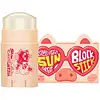What's inside
What's inside
 Key Ingredients
Key Ingredients

 Benefits
Benefits

 Concerns
Concerns

 Ingredients Side-by-side
Ingredients Side-by-side

Water
Skin ConditioningEthylhexyl Methoxycinnamate
UV AbsorberEthylhexyl Salicylate
UV AbsorberCyclopentasiloxane
EmollientTitanium Dioxide
Cosmetic ColorantButylene Glycol
HumectantButyloctyl Salicylate
Skin ConditioningCyclohexasiloxane
EmollientEthylhexyl Methoxycrylene
Skin ConditioningMethyl Methacrylate Crosspolymer
Niacinamide
SmoothingCetyl PEG/PPG-10/1 Dimethicone
EmulsifyingButyl Methoxydibenzoylmethane
UV AbsorberTriethylhexanoin
MaskingSorbitan Sesquioleate
EmulsifyingCeresin
Emulsion StabilisingMagnesium Sulfate
Triethanolamine
BufferingBetaine
HumectantSilica
AbrasiveSorbitan Olivate
EmulsifyingDisteardimonium Hectorite
StabilisingCaprylyl Glycol
EmollientPhenoxyethanol
PreservativeDimethicone/Vinyl Dimethicone Crosspolymer
Skin ConditioningAllantoin
Skin ConditioningPanthenol
Skin ConditioningDimethicone
EmollientParfum
MaskingPEG/PPG-19/19 Dimethicone
EmulsifyingGlycerin
HumectantTalc
AbrasiveCI 77499
Cosmetic ColorantCaprylhydroxamic Acid
Adenosine
Skin ConditioningDisodium EDTA
Propylene Carbonate
SolventMica
Cosmetic ColorantSodium Hyaluronate
HumectantPsidium Guajava Leaf Extract
AstringentArtemisia Princeps Extract
Skin ConditioningMorus Alba Leaf Extract
Skin ConditioningVitis Vinifera Seed Extract
AntimicrobialMethicone
Emollient1,2-Hexanediol
Skin ConditioningAlthaea Rosea Root Extract
HumectantAloe Barbadensis Leaf Extract
EmollientHydrolyzed Collagen
EmollientEthylhexylglycerin
Skin ConditioningWater, Ethylhexyl Methoxycinnamate, Ethylhexyl Salicylate, Cyclopentasiloxane, Titanium Dioxide, Butylene Glycol, Butyloctyl Salicylate, Cyclohexasiloxane, Ethylhexyl Methoxycrylene, Methyl Methacrylate Crosspolymer, Niacinamide, Cetyl PEG/PPG-10/1 Dimethicone, Butyl Methoxydibenzoylmethane, Triethylhexanoin, Sorbitan Sesquioleate, Ceresin, Magnesium Sulfate, Triethanolamine, Betaine, Silica, Sorbitan Olivate, Disteardimonium Hectorite, Caprylyl Glycol, Phenoxyethanol, Dimethicone/Vinyl Dimethicone Crosspolymer, Allantoin, Panthenol, Dimethicone, Parfum, PEG/PPG-19/19 Dimethicone, Glycerin, Talc, CI 77499, Caprylhydroxamic Acid, Adenosine, Disodium EDTA, Propylene Carbonate, Mica, Sodium Hyaluronate, Psidium Guajava Leaf Extract, Artemisia Princeps Extract, Morus Alba Leaf Extract, Vitis Vinifera Seed Extract, Methicone, 1,2-Hexanediol, Althaea Rosea Root Extract, Aloe Barbadensis Leaf Extract, Hydrolyzed Collagen, Ethylhexylglycerin
Octyldodecanol
EmollientDicaprylyl Carbonate
EmollientMethyl Methacrylate Crosspolymer
Ethylhexyl Methoxycinnamate
UV AbsorberDibutyl Lauroyl Glutamide
Skin ConditioningCaprylic/Capric Triglyceride
MaskingOctocrylene
UV AbsorberHomosalate
Skin ConditioningEthylhexyl Salicylate
UV AbsorberDibutyl Ethylhexanoyl Glutamide
Skin ConditioningButyl Methoxydibenzoylmethane
UV AbsorberTocopheryl Acetate
AntioxidantWater
Skin ConditioningLavandula Angustifolia Flower Extract
CleansingMentha Rotundifolia Leaf Extract
TonicMelissa Officinalis Leaf Extract
Skin ConditioningRosmarinus Officinalis Leaf Extract
AntimicrobialChamomilla Recutita Extract
Skin ConditioningMonarda Didyma Leaf Extract
Skin ConditioningSalvia Officinalis Leaf Extract
CleansingMentha Piperita Leaf Extract
Skin ConditioningRosa Centifolia Flower Extract
AstringentOctyldodecanol, Dicaprylyl Carbonate, Methyl Methacrylate Crosspolymer, Ethylhexyl Methoxycinnamate, Dibutyl Lauroyl Glutamide, Caprylic/Capric Triglyceride, Octocrylene, Homosalate, Ethylhexyl Salicylate, Dibutyl Ethylhexanoyl Glutamide, Butyl Methoxydibenzoylmethane, Tocopheryl Acetate, Water, Lavandula Angustifolia Flower Extract, Mentha Rotundifolia Leaf Extract, Melissa Officinalis Leaf Extract, Rosmarinus Officinalis Leaf Extract, Chamomilla Recutita Extract, Monarda Didyma Leaf Extract, Salvia Officinalis Leaf Extract, Mentha Piperita Leaf Extract, Rosa Centifolia Flower Extract
 Reviews
Reviews

Ingredients Explained
These ingredients are found in both products.
Ingredients higher up in an ingredient list are typically present in a larger amount.
Also known as Avobenzone, this ingredient is a chemical sunscreen filter that provides protection in the UV-A range.
Avobenzone is globally approved and is the most commonly used UV-A filter in the world.
Studies have found that avobenzone becomes ineffective when exposed to UV light (it is not photostable; meaning that it breaks down in sunlight). Because of this, formulations that include avobenzone will usually contain stabilizers such as octocrylene.
However, some modern formulations (looking at you, EU!) are able to stabilize avobenzone by coating the molecules.
Avobenzone does not protect against the UV-B range, so it's important to check that the sunscreen you're using contains other UV filters that do!
The highest concentration of avobenzone permitted is 3% in the US, and 5% in the EU.
Learn more about Butyl MethoxydibenzoylmethaneEthylhexyl Methoxycinnamate is an organic compound that provides UVB protection. It often goes by the more common name of octinoxate. It is created from methoxycinnamic acid and 2-ethylhexanol.
Ethylhexyl Methoxycinnamate absorbs UVB rays with wavelengths between 280-320 nm. UV absorbers protect your skin by using chemical reactions to convert UV rays into heat and energy.
UVB (290-320 nm) rays emit more energy than UVA rays. They are capable of damaging DNA, causing sunburns and are thought to be linked to skin cancer.
The state of Hawaii has banned sunscreens containing octinoxate due to its potential impact on coral reefs. More research is needed to bridge gaps in this research. The European Union allows higher levels of octinoxate in sunscreens than the US and Australia.
Ethylhexyl Methoxycinnamate is oil soluble. It is not stable and may lose efficacy when exposed to sunlight.
Learn more about Ethylhexyl MethoxycinnamateEthylhexyl Salicylate is an organic compound used to block UV rays. It primarily absorbs UVB rays but offers a small amount of UVA protection as well.
Commonly found in sunscreens, Ethylhexyl Salicylate is created from salicylic acid and 2-ethylhexanol. You might know salicylic acid as the effective acne fighter ingredient and BHA.
The ethylhexanol in this ingredient is a fatty alcohol and helps hydrate your skin, similar to oils. It is an emollient, which means it traps moisture into the skin.
According to manufacturers, Ethylhexyl Salicylate absorbs UV wavelength of 295-315 nm, with a peak absorption at 307-310 nm. UVA rays are linked to long term skin damage, such as hyperpigmentation. UVB rays emit more energy and are capable of damaging our DNA. UVB rays cause sunburn.
Learn more about Ethylhexyl SalicylateThis ingredient comes as a powder made up of small, porous, microbeads. It is used to add a silky feel to products and also helps absorb oil.
Water. It's the most common cosmetic ingredient of all. You'll usually see it at the top of ingredient lists, meaning that it makes up the largest part of the product.
So why is it so popular? Water most often acts as a solvent - this means that it helps dissolve other ingredients into the formulation.
You'll also recognize water as that liquid we all need to stay alive. If you see this, drink a glass of water. Stay hydrated!
Learn more about Water